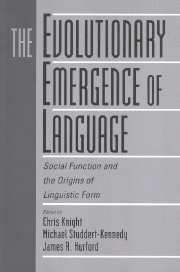Book contents
- Frontmatter
- Contents
- Contributors
- Acknowledgements
- Language: A Darwinian Adaptation?
- Part I The Evolution of Cooperative Communication
- Part II The Emergence of Phonetic Structure
- 7 Introduction: The Emergence of Phonetic Structure
- 8 The Role of Mimesis in Infant Language Development: Evidence for Phylogeny?
- 9 Evolution of Speech: The Relation Between Ontogeny and Phylogeny
- 10 Evolutionary Implications of the Particulate Principle: Imitation and the Dissociation of Phonetic Form from Semantic Function
- 11 Emergence of Sound Systems Through Self-Organisation
- 12 Modelling Language-Physiology Coevolution
- Part III The Emergence of Syntax
- Epilogue
- Author Index
- Subject Index
7 - Introduction: The Emergence of Phonetic Structure
Published online by Cambridge University Press: 24 November 2009
- Frontmatter
- Contents
- Contributors
- Acknowledgements
- Language: A Darwinian Adaptation?
- Part I The Evolution of Cooperative Communication
- Part II The Emergence of Phonetic Structure
- 7 Introduction: The Emergence of Phonetic Structure
- 8 The Role of Mimesis in Infant Language Development: Evidence for Phylogeny?
- 9 Evolution of Speech: The Relation Between Ontogeny and Phylogeny
- 10 Evolutionary Implications of the Particulate Principle: Imitation and the Dissociation of Phonetic Form from Semantic Function
- 11 Emergence of Sound Systems Through Self-Organisation
- 12 Modelling Language-Physiology Coevolution
- Part III The Emergence of Syntax
- Epilogue
- Author Index
- Subject Index
Summary
What is special to a grammatical utterance (i.e., to a linguistic event) is not that it has meaning, expresses feelings, or calls for a relevant response – these are all common to many human activities – but that it is socially transmissible.
Zellig Harris (1968: 7)In the passage above, Harris was concerned to explain why the elements of a language (phonemes, morphemes, words) are discrete, preset (that is, known to both speakers and hearers) and arbitrary. Only if the elements have these properties, he argued, can a hearer reliably transmit, or repeat, an utterance to another. If the elements were continuously variable, spontaneously invented or iconic, they would be subject to compound error in transmission, and their communicative utility would be limited.
The properties that afford reliable transmission from speaker to hearer are also those that afford reliable transmission from one generation to the next, from adult speaker to child hearer/learner. It is this aspect, transmission across generations by learning, that has enabled language to evolve, in perhaps no more than some tens of thousands of generations, from inarticulate cry to articulate speech.
All five of the following chapters deal with the transmission of words across generations. Each takes for granted a capacity for verbal symbolic reference; all but the last then address the emergence of the discrete phonetic structures on which reliable transmission of verbal symbolic reference depends. In focusing on transmission these chapters also recognise, implicitly or explicitly, the critical role of the learning child.
- Type
- Chapter
- Information
- The Evolutionary Emergence of LanguageSocial Function and the Origins of Linguistic Form, pp. 123 - 129Publisher: Cambridge University PressPrint publication year: 2000



